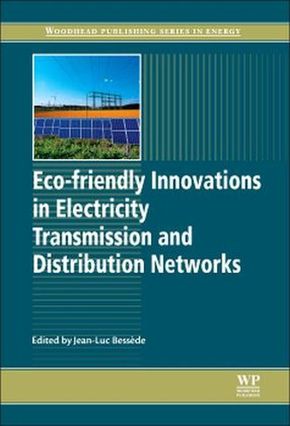Eco-friendly Innovations in Electricity Transmission and Distribution Networks
| Verlag | Woodhead Publishing |
| Auflage | 2014 |
| Seiten | 442 |
| Format | 15,8 x 23,7 x 3,7 cm |
| Gewicht | 770 g |
| Artikeltyp | Englisches Buch |
| Reihe | Woodhead Publishing Series in Energy |
| ISBN-10 | 178242010X |
| EAN | 9781782420101 |
| Bestell-Nr | 78242010UA |
Electricity transmission and distribution (T&D) networks carry electricity from generation sites to demand sites. With the increasing penetration of decentralised and renewable energy systems, in particular variable power sources such as wind turbines, and the rise in demand-side technologies, the importance of innovative products has never been greater. Eco-design approaches and standards in this field are aimed at improving the performance as well as the overall sustainability of T&D network equipment. This multidisciplinary reference provides coverage of developments and lessons-learned in the fields of eco-design of innovation from product-specific issues to system approaches, including case studies featuring problem-solving methodologies applicable to electricity transmission and distribution networks.
Inhaltsverzeichnis:
Related titles Dedication List of contributors Woodhead Publishing Series in Energy Acknowledgements Introduction Part One. Eco-design and innovation in electricity transmission and distribution networks1. The implications of climate change and energy security for global electricity supply: The Energy (R)evolution1.1. Greenhouse emissions and climate change1.2. Primary energy resources1.3. The fossil fuels1.4. Carbon dioxide capture and storage and clean coal technologies1.5. Uranium resources and nuclear energy1.6. Contribution of all fossil and nuclear fuels 1.7. What is the solution for saving the planet?1.8. Development of global energy demand1.9. The hydrogen economy 1.10. Conclusions2. Key performance indicators in assessing new technology for electricity transmission and distribution networks2.1. Introduction2.2. Key performance indicators to assess the environmental impact of transmission and distribution networks2.3. Test networks2.4. A method ology for evaluating KPIs2.5. Results3. Improving European Union ecodesign standardization3.1. Standardization policy3.2. Product ecodesign3.3. Ecodesign methodology3.4. Ecodesign for energy-related products: The new scope of the ErP directive3.5. Applying ecodesign directive to electricity transmission and distribution technology: power transformers3.6. Methodology for ecodesign of energy-related products (MeerP)3.7. Two European initiatives on resource efficiency and critical raw materials3.8. The product environmental footprint3.9. Future trendsReferences and further readingList of acronyms used4. Approaches for multi-objective optimization in the ecodesign of electric systems4.1. Introduction4.2. Ecodesign principles4.3. Matching models and algorithms4.4. Multi-objective algorithms and techniques4.5. Optimization problem transformation techniques4.6. Summary: using different techniques5. Strategic environmental assessment of power plants and electricity transmission and distri bution networks5.1. Introduction5.2. SEA in different countries5.3. The contribution of SEA to sustainability5.4. SEA in the power planning process5.5. Stages of SEA5.6. SEA indicators: measuring differences within power plan alternatives5.7. Conclusions and future trends5.8. Sources of further information and advice Part Two. Application and assessment of advanced equipment for electricity transmission and distribution networks6. Life cycle assessment of equipment for electricity transmission and distribution networks6.1. Introduction6.2. Introduction to life cycle assessment6.3. Applying LCA in practice: power transformer6.4. Applying LCA in practice: a 765 kV AC transmission system6.5. Conclusions7. Superconducting DC cables to improve the efficiency of electricity transmission and distribution networks: An overview7.1. Introduction7.2. Superconducting cable systems: key elements7.3. Superconducting materials7.4. Cable conductors and electrical insulation7.5. Cable cryostat 7.6. Cable terminations and joints7.7. Cryogenic machine7.8. Superconductive cable system configurations7.9. Power dissipation sources in the superconducting system7.10. Power losses from AC ripples7.11. Com

